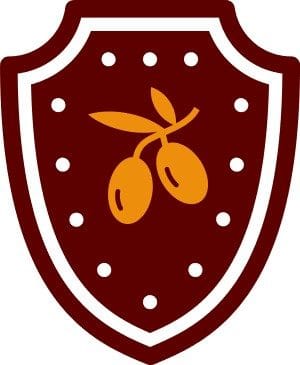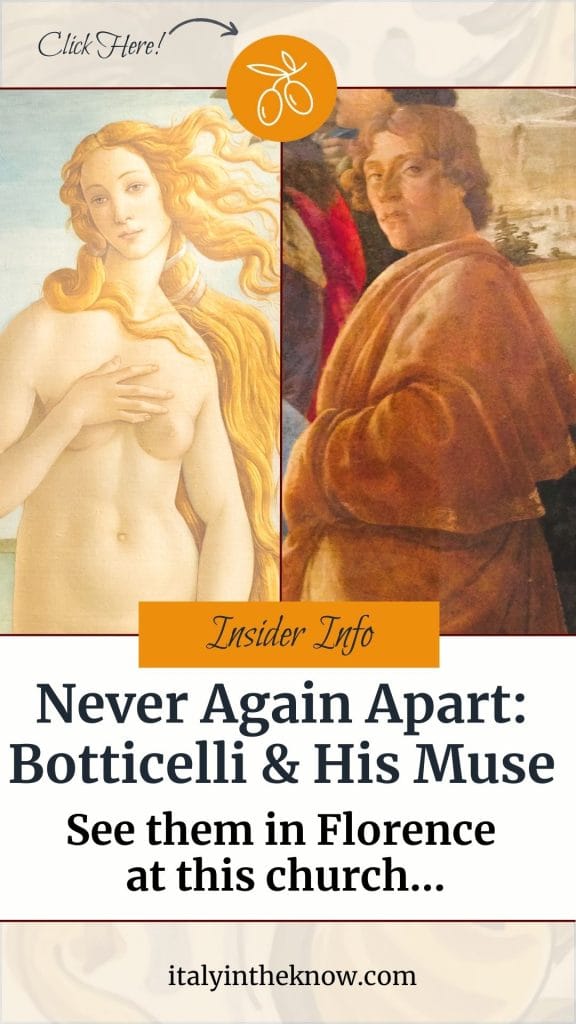5 Remarkable Churches You Want to See in Florence, Italy

Florence churches are famous for their historical significance and artistic masterpieces. However, with over 100 churches in the city, selecting which ones to visit can be quite challenging.
Here, you’ll discover some of the most famous Florence churches along with essential details to help you choose which ones best match your interests and travel style. Each of these five churches is rich in history and art, and they all have their own unique and special stories.
As cornerstones of the community and its history, many Florence churches offer free or low cost entry, making them an important and accessible addition to your itinerary.
Use this table of contents to easily navigate within the post:
- Basilica of Santa Maria Novella
- Church of San Salvatore in Ognissanti
- Church of Santa Maria del Carmine
- Basilica of Santa Croce
- Basilica of San Miniato al Monte
Note: This post does not include the Cathedral of Santa Maria del Fiori, aka the Duomo. Instead, the Cathedral is grouped with the other sites that make up Florence’s religious center. Check here to learn more about visiting the Duomo Complex which includes the Cathedral, Giotto’s Tower, the Baptistry, the excavations of Santa Reparata, and the Duomo Museum.
Basilica of Santa Maria Novella – Dominican

This Dominican church borders the piazza near the Santa Maria Novella Train Station. For nearly 300 years, the piazza hosted rousing annual chariot races. Today, its border of pink roses provides a delightful setting for the church.
Santa Maria Novella is a large complex consisting of:
- Basilica
- Convent
- Cloister of the Dead
- Green Cloister
- Spanish Chapel
- Ubriachi Chapel
- Refectory
Inside are works by many leading artists of the Middle Ages and Renaissance. These include Brunelleschi, Masaccio, Ghirlandaio, Orcagna and Filippino Lippi.
Dominican friars started basilica construction in the early 13th century. They built on the site of an ancient 6th century church.
Architecturally, Santa Maria Novella’s interior is Gothic. However, the façade is a layer cake with Gothic on the lower part and Renaissance stacked above.
Then, as now, people periodically have an urge to update and renovate. This happened in the mid-15th century.
Then, Giovanni Rucellai, a wealthy wool merchant, funded a project to modernize the church’s appearance.
It was a tough project for the architect, Leon Battista Alberti. Six prominent citizens were entombed within the arches of the exterior walls (still visible today). So, he was stuck with keeping the first level Gothic.
The result you see today confirms that he was up to the task. Geometrical shapes interrelate and complement each other.

The large sun at the top is an emblem of the neighborhood and the Dominican convent connected to the church. In the strip directly below the top pediment, you’ll see the sponsor, Rucellai’s name immortalized.
For an incredible experience, see this church in a Florence itinerary.
Highlights
Tornabuoni Chapel

The Tornabuoni Chapel is situated behind the main altar. It features frescoes painted by Ghirlandaio and his apprentices, including a youthful Michelangelo.
On the left side, you’ll find charming scenes depicting the life of the Virgin Mary. One standout panel portrays Mary’s birth. The vibrant joy on the faces of those attending to her is particularly compelling.
Like People magazine, the frescoes feature celebrities and wealthy elite of the time.
Among them you’ll see Giovanna Tornabuoni. She was Lorenzo’s cherished wife, who died in childbirth before the project began. Her portrayal is a tribute to her memory and highlights her love and important role in the family.
Filippo Strozzi Chapel
This Strozzi Chapel displays the genius of Filippino Lippi. Stories from the life of St. John and St. Philip unfold here.
The tone signifies the unsettling times following the death of Lorenzo de’ Medici. Notice the farting dragon in the scene of St. Philip Driving the Dragon from the Temple of Hieropolis.
Strozzi of Mantua Chapel
The Strozzi of Mantua Chapel (not to be confused with Filippo’s above) requires a worthwhile climb. The chapel is from an earlier time following the plague that devastated Florence in 1348.
Frescoes here are by Nardo di Cione and his brother Andrea Orcagna. The theme is from Dante’s Divine Comedy. There is a sober, grim beauty here reflecting the Last Judgement, Hell, and Paradise.
Refectory – Last Supper

In the Refectory, you find the first Last Supper in the history of art made by a woman. Painted in the 1560s by self-taught nun, Plautilla Nelli, it is nearly 22 feet long. The work shows her unique style and is an emotional portrayal of this momentous event.
After centuries in storage, the painting underwent extensive restoration. It was hung at Santa Maria Novella in the fall of 2019.
Left Nave – The Holy Trinity
In the third arcade on the left nave, you’ll find the Trinity painted by Masaccio. This is a pioneering work. It reintroduced perspective and the illusion of three-dimensional space on a flat surface. This was the first use of perspective since ancient times.
What Happened Here

1374 – In the Spanish Chapel, St. Catherine of Siena was interrogated for heresy. She was cleared and later became the Patron Saint of Europe, Italy, and Siena.
In the chapel frescoes, look for the “Domini canes” (black and white dogs). These symbolize the Dominicans who were fierce defenders of Catholicism.
1438-1439 – Pope Eugenius IV presided over the Council of Florence at Santa Maria Novella. Its goal was to repair the rift between the Greek and Latin Churches. A division which occurred almost 400 years before. The effort failed and Roman Catholic and Greek Orthodox remain separate to this day.
1612 – Father Tommaso Caccini denounced Galileo’s theory at Santa Maria Novella. This was from the pulpit you see today midway along the nave of the church.
Galileo maintained that the earth revolved around the sun, which was controversial at the time. Since Galileo had many powerful friends, his view was only declared “close” to heretical.
However, later in Rome he was found suspect of heresy and placed under house arrest.
Unique Add-On
Officina Profumo-Farmaceutica Di Santa Maria Novella

Visiting the pharmacy of Santa Maria Novella (Officina Profumo-Farmaceutica Di Santa Maria Novella) is a unique, enchanting add-on experience. It is one of the oldest pharmacies in the world.
Access by the monks was originally from the south side of the Cloister. Today, you can visit from Via della Scala around the corner to the right as you exit the church.
The Dominican friars cultivated medicinal plants and herbs in their gardens. In 1612, the friars officially opened their pharmacy to the public.
Their first recorded product was rose water in 1381. This was used as a disinfectant during plague epidemics.

As you enter, breathe in the pharmacy’s unique and timeless aroma (available as pot pourri). The shop sells herbal remedies as well as skincare, body, and bath products. These use recipes developed over the ages.
The pharmacy is located on Via della Scala, 16, around the corner from the Basilica of Santa Maria Novella.
Church of San Salvatore in Ognissanti – Franciscan
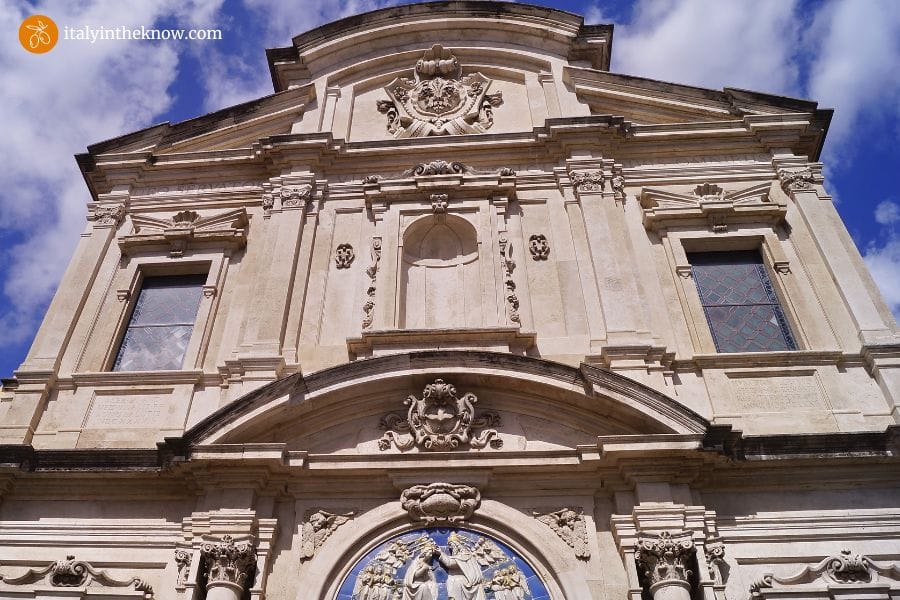
The Church of San Salvatore in Ognissanti is off the beaten path on the west side of Florence. While lesser known, it has stunning art from the late Gothic and Renaissance periods.
Its history is interesting and diverse. The church was founded in 1239 by a group of Umiliati who came to Florence from the northwestern part of Italy.
The Umiliati (the Humble Ones) was a Catholic order that emphasized living a pious, simple life. Started in 1080, the order was active until the 15th century.
As expert wool workers, they built the church near the river, which was ideal for wool processing.
The Umiliati thrived and built the church and convent. They named the church, Ognissanti, meaning “all saints” in honor of Christian saints and martyrs.
With wealth from wool, the brothers commissioned works of art by famous artists. These late Gothic and Renaissance artists included Giotto, Botticelli, and Ghirlandaio.
The Baroque façade you see today was completed in 1637. At the top are the arms of Florence. Below it a terracotta lunette shows the Coronation of the Virgin with Saints.
Inside, the church retains its original Gothic architecture. But in the early 17th century it was remodeled in the Baroque style.
Highlights
Crucifix

A beautiful sixteen-foot crucifix by Giotto hangs suspended in the church. It was completed in the 1300s, probably 20 years after the one he created for the Church of Santa Maria Novella.
The expensive blue lapis lazuli pigment gives the piece a glowing vitality. While a crucifixion theme, the work is actually a triumph, showing the risen Christ above.
Doctors of the Church – Saint Augustine and Saint Jerome
The Catholic Church’s highest honor is Doctor of the Church. This is given to individuals recognized for significant contributions to theology or doctrine.
At Ognissanti, paintings of two Doctors of the Church face each other across the aisle. Both frescos were completed in 1480, with similar theme and composition.
Ghirlandaio painted Saint Jerome in His Study. The fresco shows a serene Jerome at his desk writing among books and letters.
This is a fitting setting for Jerome who translated the Greek Bible into Latin. The translation became the Vulgate Bible used for over 1,000 years.
Facing St. Jerome is St. Augustine in his study by Botticelli. The painting shows St. Augustine receiving a vision at the moment of St. Jerome’s death.
The Vespucci family commissioned Botticelli to paint the fresco, and, at the top of the painting, you can see their coat of arms.
What Happened Here
1454 – Amerigo Vespucci was born in Florence. His explorations spread the idea that the Americas (which bear his name) were distinct from Asia.
The Vespucci family, wealthy patrons of the church, had a private chapel at Ognissanti. Amerigo worshipped here often in his youth, and he is buried in the church.

(Young Amerigo is on the left between the man in the red robe and Virgin Mary)
On the right aisle is a fresco by Ghirlandaio. The painting shows a young Amerigo with his family protected by the Madonna della Misericordia.
1476 – Amerigo’s cousin by marriage was Simonetta Vespucci. She was a noted beauty of the time who died in her early twenties and is interred here. Known as Botticelli’s muse, her likeness is in many famous paintings. One of the most famous pieces where you see her is in Botticelli’s Birth of Venus.
1510 – Sandro Botticelli (Alessandro di Mariano di Vanni Filipepi) died and is buried here. Ognissanti was Botticelli’s parish church. He was born nearby and lived his life in the neighborhood.
After Simonetta Vespucci’s untimely death, Botticelli asked to be buried at her feet. Thirty- four years later his wish was granted, and he rests near his beloved Simonetta.
Unique Add-On
Cenacolo di Ognissanti

If you visit on certain days, you have a unique opportunity to see Cenacolo di Ognissanti fresco next door. This is the painting that influenced Leonardo da Vinci’s famous Last Supper in Milan.
The Refectory (Cenacolo) of Ognissanti’s Convent is where the friars had their meals. In it is the Last Supper by Domenico Ghirlandaio, finished in 1480.
The fresco takes up an entire wall and was completed as an optical illusion to look like an extension of the room. The wood stalls in the fresco are like what the friars sat on to eat.
Ghirlandaio was a master of storytelling in his works. So, the fresco is full of symbols that those living at the time would have understood.
The orange and other citrus trees in the orchard at the back symbolize eternal life. In the window, you’ll see a peacock which is the symbol of immortality.
Look for OSSCi, the symbol of the Ognissanti, on pitchers, the vase of roses, and the brass tray.
The heavy linen tablecloth is stitched with blue hippogriffs in the style of Perugia. (Harry Potter fans will recognize the hippogriffs, which are a combination of horse and the mythical half-eagle griffin.)
Entry is free, however the days and times open vary so check the website for current information.
Church of Santa Maria del Carmine – Carmelite

Across the Arno River and off the beaten track is the austere Church of Santa Maria del Carmine. Adjacent is a Carmelite monastery. The church has a rough, unfinished façade that hides many treasures inside.
While founded in the 11th century, the church has an interesting mix of art. This mixture is due to renovations and fires.
As you enter through the cloister, enjoy the serene beauty. The Carmelites are a secluded order. They emphasize silence and solitude to deepen one’s relationship with God. So, these cloister spaces were particularly important.
While the American Revolutionary War waged, Florence was starting to rebuild the church after a devastating fire.
As a result, when you enter the church today, you’re stepping away from the Renaissance. Instead, you see a vast, radiant space combining Rococo elegance with Neoclassic simplicity.
Highlights
Brancacci Chapel

Fortunately, the Brancacci Chapel survived the fire that ravaged most of the church. So, we can appreciate the frescoes that inspired Michelangelo and other famous artists.
The fresco series tells the stories of St. Peter. It is a unique series because it was painted by three different artists.
Masolino and Masaccio worked together from 1423 to 1428. However, the Brancacci family was exiled from Florence. So, without patrons the chapel sat unfinished until their return in 1474.
In the early 1480s, the Brancacci family commissioned Filippino Lippi to finish the project.
Masolino’s part of the frescoes are late gothic with poetic themes and no perspective. In contrast, Masaccio rediscovered the use of perspective lost from ancient times. Finally, Lippi brought his own genius while honoring the legacy of the others.

While there, notice the different facial expressions and emotions portrayed in the series. The Expulsion From Paradise is profound in displaying the sorrow and despair of Adam and Eve.
You’ll see Carmelite monks throughout the series. Recognize them by their habits of white mantles over brown robes.
Self-portraits of all three artists appear in the chapel frescos. In the inset of St. Peter Enthroned above, an intense Masaccio looks out on the far right. Between him and the wall, you catch a glimpse of the older Masolino.
Corsini Chapel
The Corsini Chapel was also spared from the fire and the Corsini family remains its patrons to this day. It is a great example of Baroque style in Florence.
The chapel is a tribute to St. Andrew who was a Carmelite monk and ancestor of the princely Corsinis. Here you’ll find a lavish, ornate space with works by Silvani, Giordano, and Foggini.
What Happened Here
The renowned artist, Filippino Lippi, spent part of his youth at the monastery. There he joined his father, Filippo Lippi, who was also a famous artist and a Carmelite monk.
Before that, Filippino spent time at Florence’s Hospital of the Innocents, which was Europe’s first orphanage. This was after the passing of his mother, Lucrezia Buti, who was an Augustinian nun.
In his twenties, Filippino received a commission and returned to the Brancacci Chapel. There he finished the frescoes which he had known since his childhood.
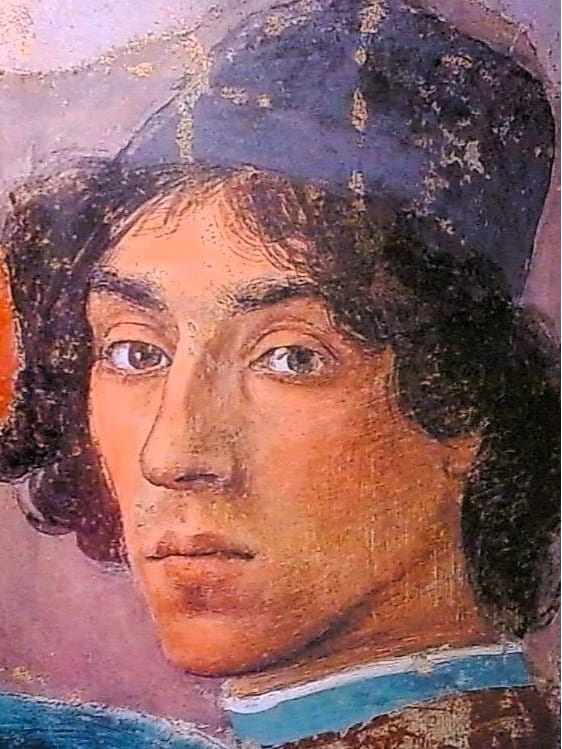
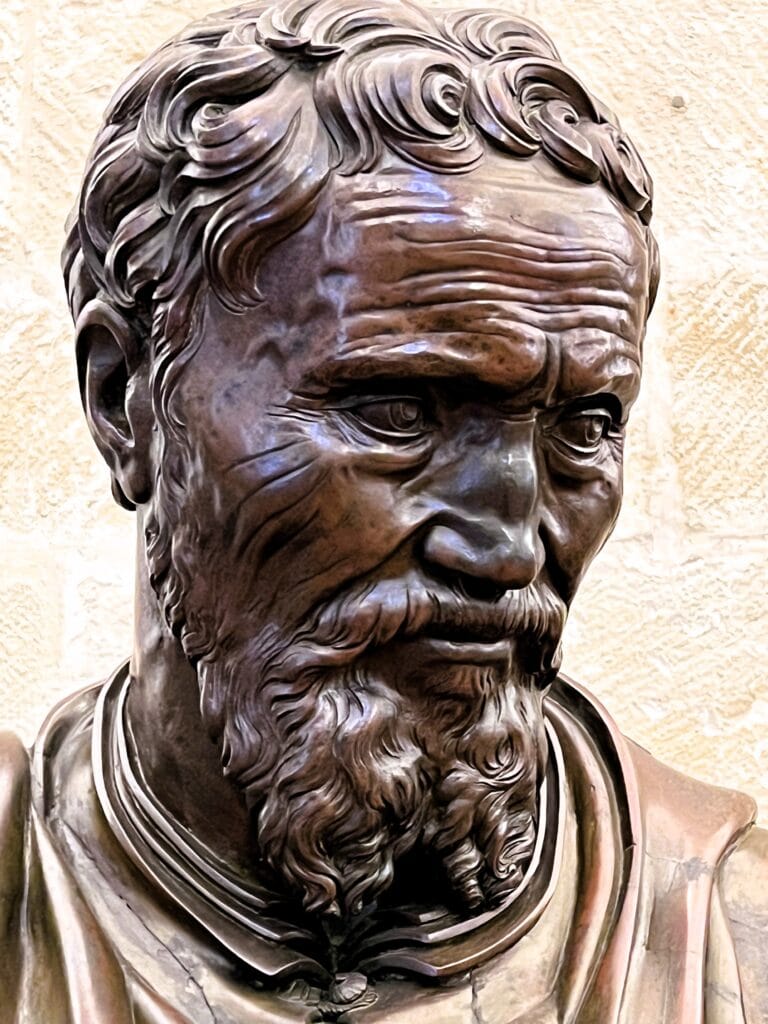
Many Renaissance artists visited the chapel to learn from the frescoes, including Michelangelo.
While he was studying the frescos, a fight broke out with a jealous rival artist. This led to the broken, disfigured nose we see in art depicting Michelangelo.
To check availability and buy tickets, go to the official website. You must reserve a spot ahead of time.
Since you are in the Oltrarno (across the Arno River), take the opportunity to see a less touristy part of Florence.
Basilica of Santa Croce – Franciscan
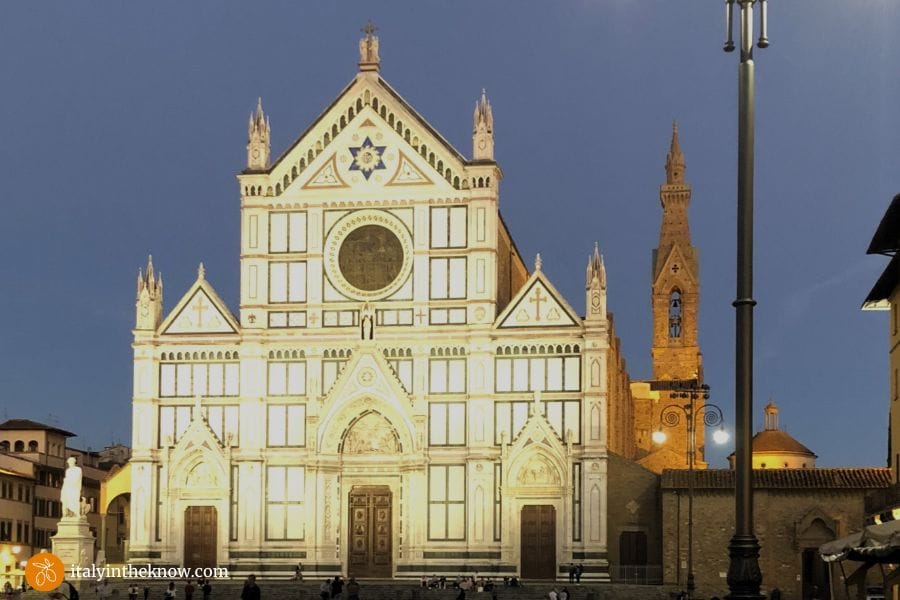
The church started in the 13th century in one of the city’s poorest districts at that time. Founded by the Franciscan Order, it focused on serving the poor.
Today, it is one of the largest Franciscan churches in the world. Over time, the church became a mausoleum of prominent Florentines followed by a place with civic and political value.
Some of history’s most famous people are buried there. Those interred include Michelangelo, Galileo, and Machiavelli.
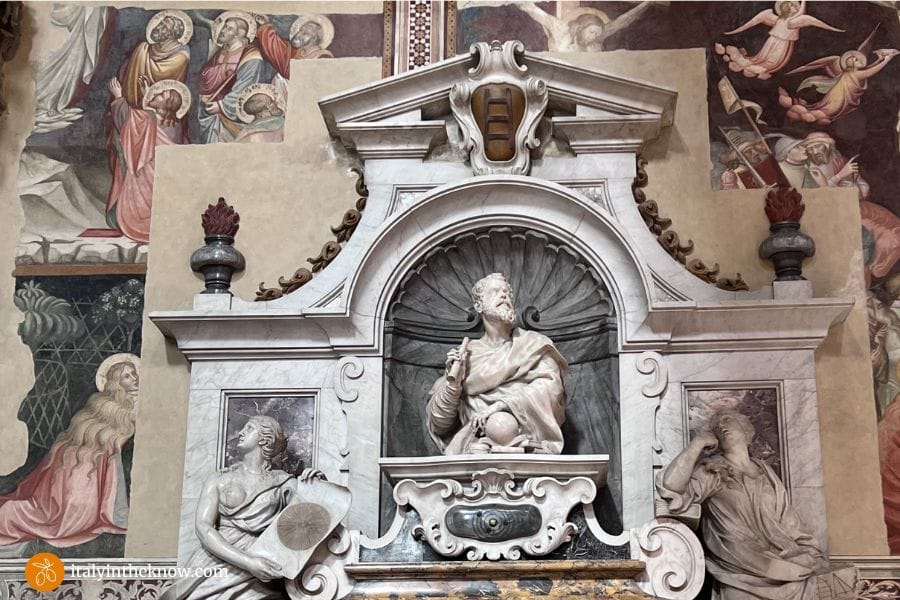
Arnolfo di Cambio designed the church, and it has a distinctly Gothic interior of that era. In places, you can still see parts of the original frescoes from that time on the walls.
The church’s highlights include frescoes by Giotto, Gaddi, and Agnolo as well as over 200 tombs.
Because the church is huge and filled with art, I recommend getting the audio guide. This is a great way to take it all in (at your own pace) and is well worth the price.
With it you’ll:
- find the early wall frescoes that covered the church,
- learn the back story to a pulpit in the nave and the odd sized tomb underneath,
- and see the tomb of the man who sacrificed himself to save Lorenzo de’ Medici from the Pazzis at the Duomo on Easter 1478.
Entry is on the left side of the church past the statue of Dante. As you go in, you can pick up an audio guide just past the ticket desk.
For a fantastic experience, see this church as part of a Florence itinerary.
Highlights
Floor Gravestones
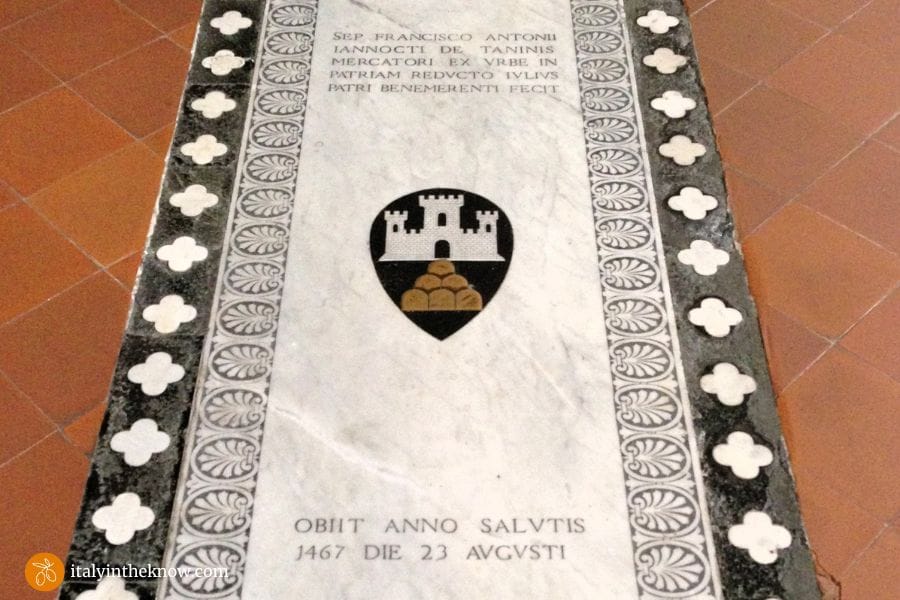
One thing that stands out at Santa Croce is the large number of gravestones on the floor. These riveting marble bas reliefs are scattered throughout the church.
Today there are over 250. However, in the 17th century there were more than 1,000…imagine that.
While a status symbol, the gravestones were also a sign of humility because they would be walked on.
The gravestones fall into three groups:
- important Franciscans
- military (knights and commanders)
- members of prominent Florentine families.
Bardi and Peruzzi Chapels
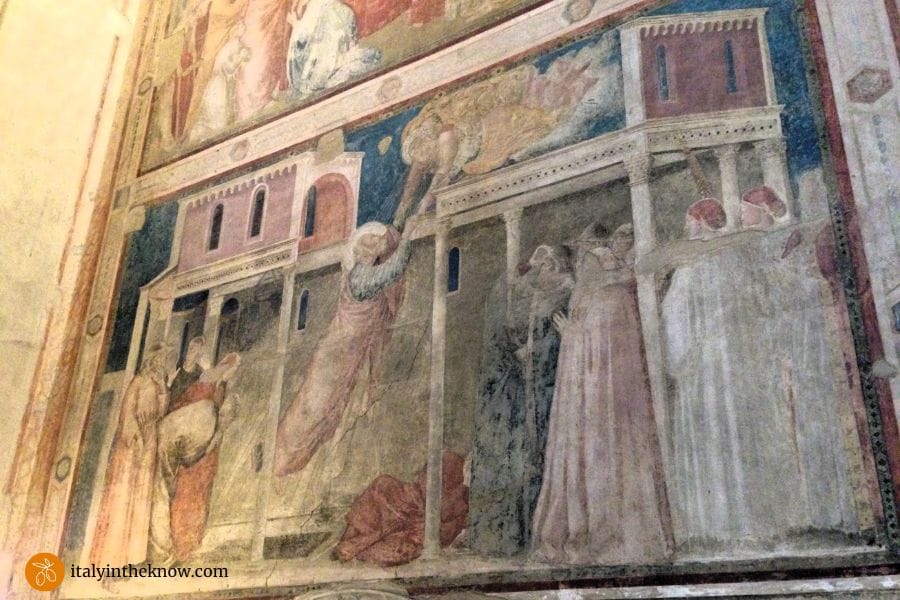
In the 12th century, the Bardi and Peruzzi families commissioned Giotto di Bondone to paint their chapels. During the Late Middle Ages, Giotto was setting new standards for artistic expression and he was a highly sought after artist.
His work was innovative in its use of lifelike figures and emotional storytelling. In addition, Giotto’s work has depth. This was a major departure from the non-dimensional works of the Middle Ages.
The Peruzzi Chapel is adorned with scenes from the lives of Saint John the Baptist and Saint John the Evangelist. Completed later, the Bardi Chapel focuses on the life of Saint Francis.
The narratives unfold with remarkable depth and emotion. One example is the scene of St. Francis’ funeral showing the grieving friars.
Cavalcanti Annunciation

On the right aisle, Donatello’s Annunciation catches your attention with its quiet beauty. The work is set in a classical frame showing the influence of Donatello’s time in Rome studying its ancient ruins.
Carved in pietra serena with gildings, it is elegant and unusual. The figures express emotion while the overall work has a serene quality.
Pazzi Chapel
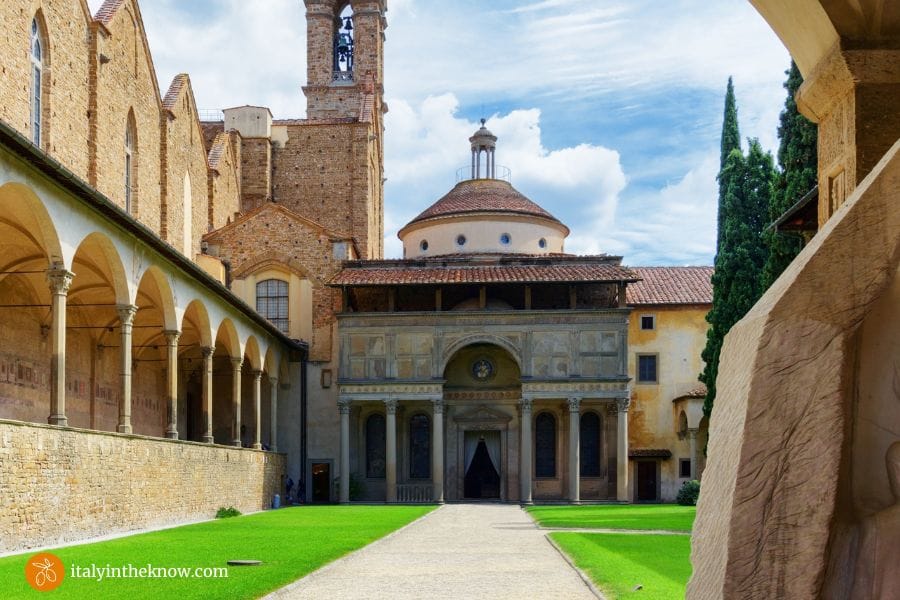
In the door beyond Donatello’s Annunciation, pass into the first cloister. There you’ll see the Pazzi Chapel ahead on the left.
In 1429, Andrea de’ Pazzi commissioned Filippo Brunelleschi to design a chapter house for the monks that would also serve as the family’s chapel.
This was one of many projects the architect of the Duomo’s dome worked on at the same time as its construction.
The Pazzi Chapel represents Renaissance ideals of harmony, balance, and elegance. In contrast to the church, it has an austere simplicity.
The chapel is essentially a cube topped by a circle. Brunelleschi used the same measurement, 20 Florentine braccia (about 23″), throughout the structure. This gives the space a uniform quality.
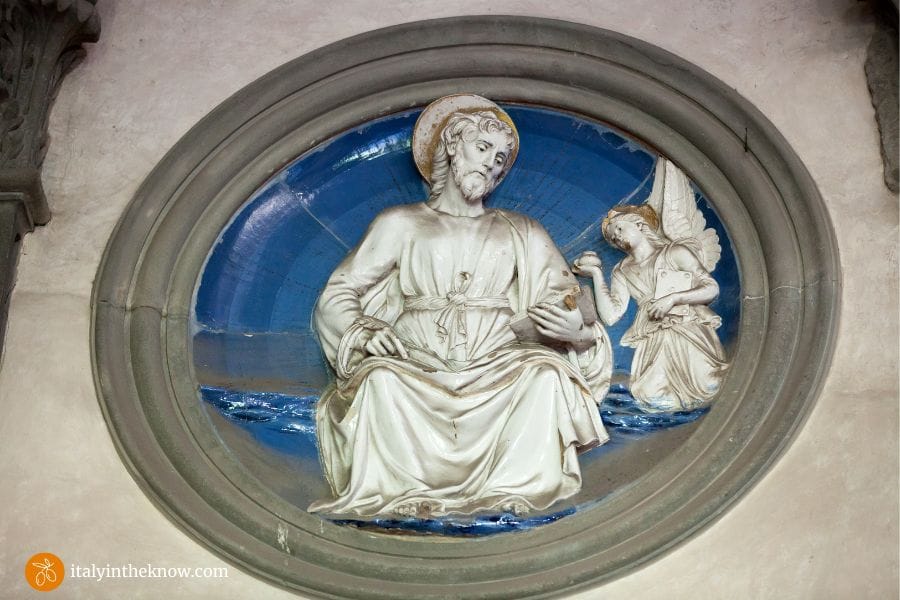
The inside is decorated with terracotta medallions of the twelve apostles by Luca della Robbia. These enhance the plain surfaces and add to the unity of the space.
What Happened Here
1345 – The square in front of the basilica was the site of one of the earliest efforts to organize workers. Ciuto Brandini spoke to woolworkers encouraging them to form a group with a common assistance fund.
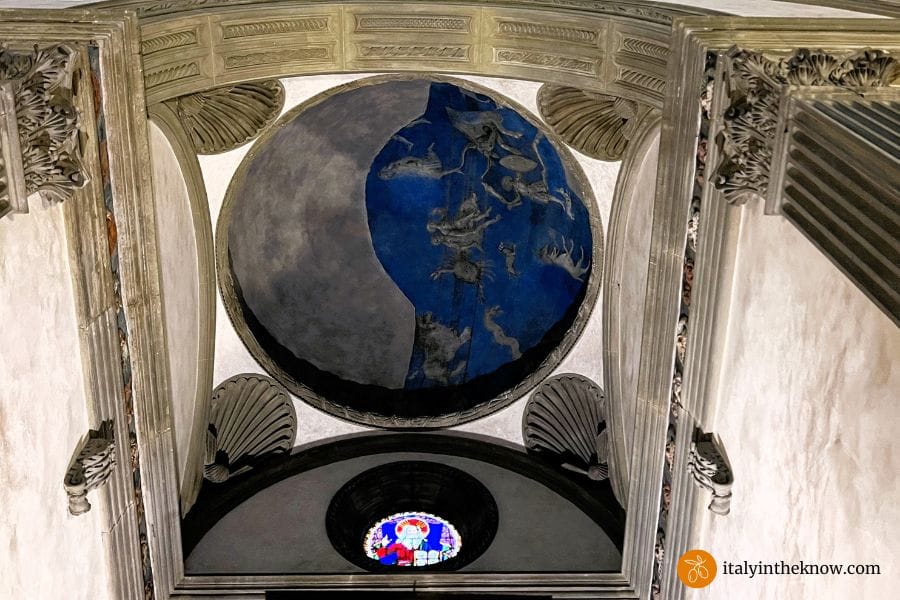
July 4, 1442 – The event remains a mystery. Yet, the night sky painted in the cupola above the altar of the Pazzi Chapel shows the constellations visible over Florence on that date.
To add to the mystery, the same sky is painted in the vault of the Old Sacristy of San Lorenzo. San Lorenzo had the Medici as patrons. Since the Pazzis and Medicis were rivals, it is remarkable that both chose to immortalize this date.
1475 – Giuliano de’Medici (Lorenzo the Magnificent’s brother) wins a joust at a tournament of knights held in the square.
1478 – Francesco Nori, prior of the Florentine Republic, was interred at Santa Croce. During mass on Easter Sunday, 1478, he died trying to shield Lorenzo de’ Medici.
The event which occurred at the Duomo became known as the Pazzi conspiracy. After the conspiracy, Lorenzo commissioned Antonio Rossellino to build Nori’s mausoleum.
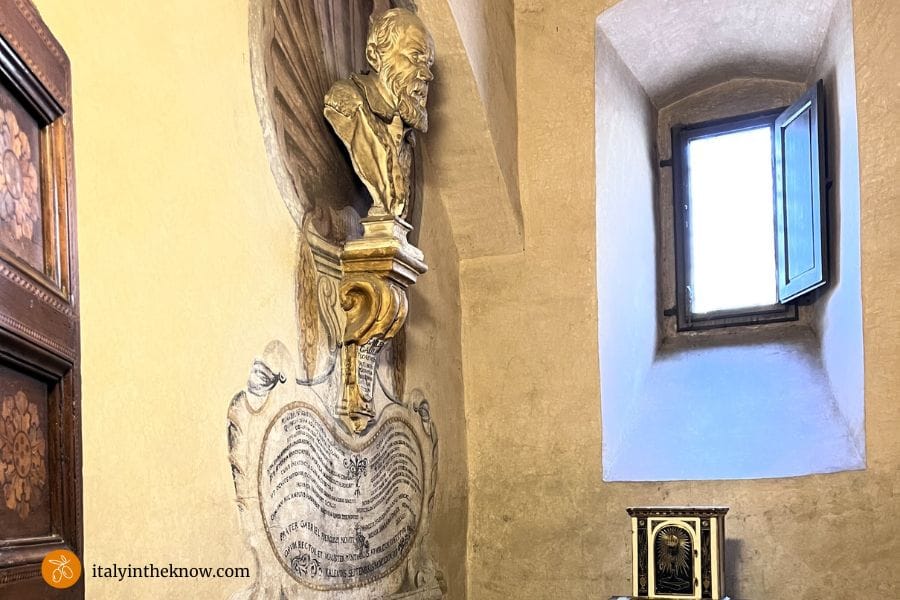
1642 – Galileo Galilei, noted physicist and astronomer, was interred in the Medici Chapel at Santa Croce. His condemnation by the Inquisition prevented burial inside the church proper.
1737 – Tomb of Galileo Galileo was erected within the church and his body moved. This followed achange in Catholic dogma acknowledging the heliocentric approach Galileo proposed.
Unique Add-On
Scuola del Cuoio (Leather School)
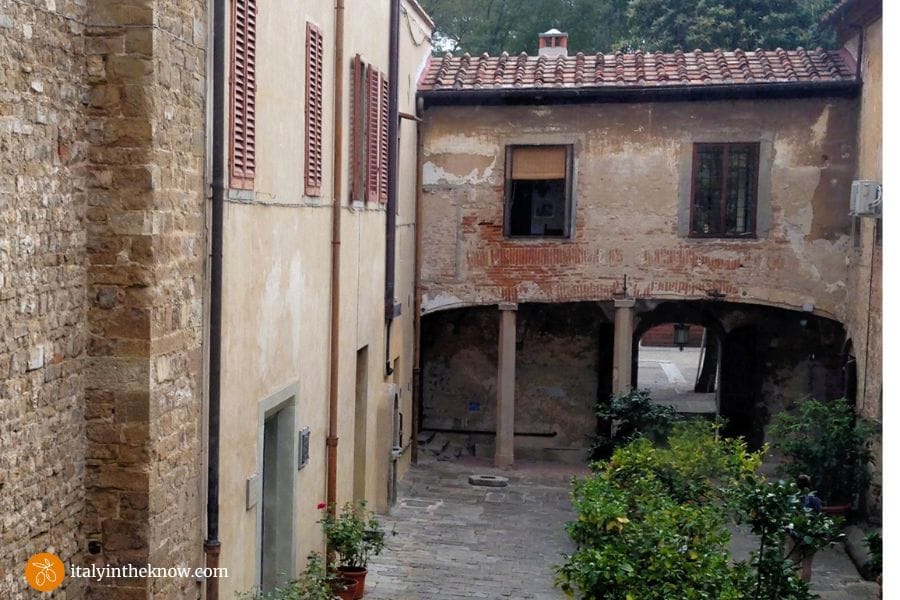
In the aftermath of World War II, there was concern for war orphans. Specifically, to give them a chance to learn a practical trade so they could earn a living.
The Franciscan friars at the monastery of Santa Croce joined with the Gori and Casini families (leather craftsman since the 1930s). Together, they established a leather school, Scuola del Cuoio.
Over the decades, Scuola del Cuoio has had many famous visitors, including the English Royal Family, President Reagan, Steven Spielberg, Jack Nicklaus, and Robert Downey Junior.
There is no entry charge. To get there, go past the left side of the Basilica of Santa Croce. Just beyond the church you will see a sign for the leather school. Turn right, go a short distance, and enter the courtyard of the school.
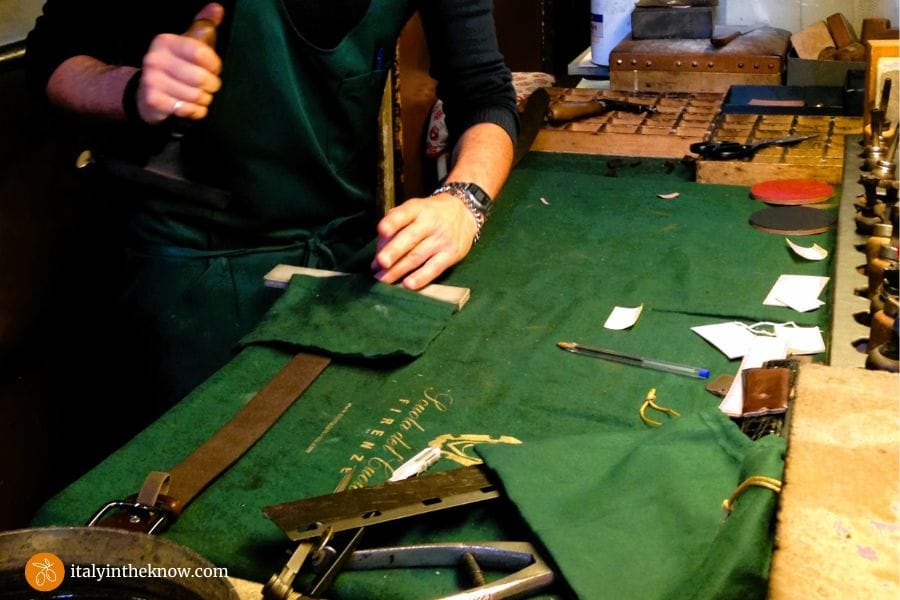
While there, you’ll see artisans creating leather goods. Their workspace is the old dormitory space within Santa Croce’s monastery. The leather production process includes hand-tooling, embossing, and stitching.
The school has an onsite showroom which offers a unique shopping experience with opportunities to bring home a piece of Florentine craftsmanship. One option is to have your purchase personalized while you watch.
Personalized belts are a popular choice for gifts. I photograph the artisan adding the initials and include this image with the belt.
For hours and more information check their website.
Basilica of San Miniato al Monte – Benedictine, currently Olivetan Benedictine
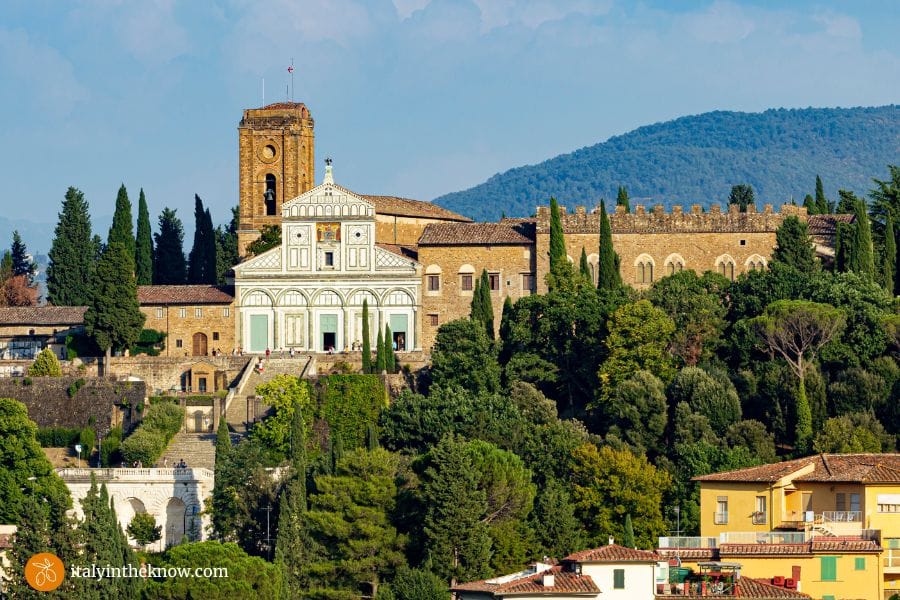
The Basilica of San Miniato gives you a fantastic opportunity to step away from the city center. Getting there requires a bit of a climb, after all “al Monte” means “to the mountain”. But, the stunning view of Florence and this beautiful church make it worthwhile.
For those who prefer to avoid the steep walk, a bus and taxis are alternatives.
The basilica was built in the early 1000s with 13th century additions. One of Florence’s oldest churches, it is an extraordinary example of Romanesque architecture.
You may notice similarities to later structures in Florence. Indeed, its façade inspired that of the Basilica of Santa Maria Novella.
As you enter, above the center door Christ gives his blessing flanked by Mary and St. Minias. This glorious mosaic dates from the early 13th century.
The interior is vast and airy with its high trussed ceiling. Inside, the geometric patterns of green and white marble continue from the exterior. The floor mosaics rich in symbolism are particularly striking.
Eagles you see are emblems of the Calimala (cloth merchants). This was one of Florence’s seven major guilds, and it was responsible for the church’s upkeep.
Highlights
Crypt
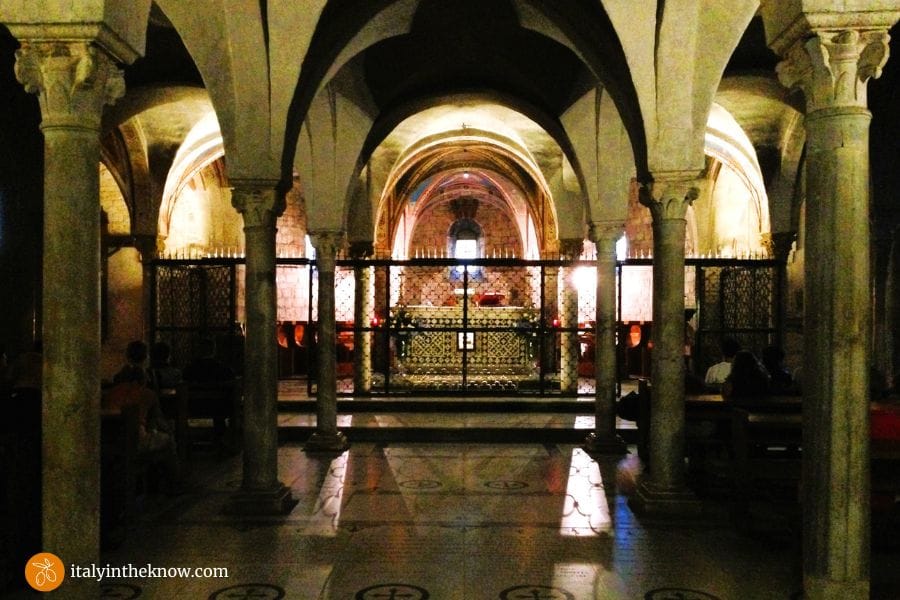
The crypt is the oldest part of the church and is filled with pillars, some from ancient Roman baths. Its altar is said to contain the bones of St. Minias. Evening mass is held there with traditional chant of the monks from the adjoining monastery.
Chapel of the Cardinal of Portugal
The Chapel of the Cardinal of Portugal is the only tomb within the church. It is a monument to Cardinal James of Lusitania who was also a Portuguese Prince.
While traveling from Rome to Mantua in the summer of 1459, the Cardinal fell ill and died in Florence at the age of 25. His uncle, the King of Portugal, commissioned well known artists to construct the Cardinal’s tomb and chapel.
Together, they created a remarkable Renaissance chapel. Today, the chapel still contains all the elements as originally designed. Collaborating artists include:
- Antonio Manetti
- Antonio Rossellino
- the Pollaiuolo brothers
- Lucca della Robbia
- Alesso Baldovinetti.
Sacristy
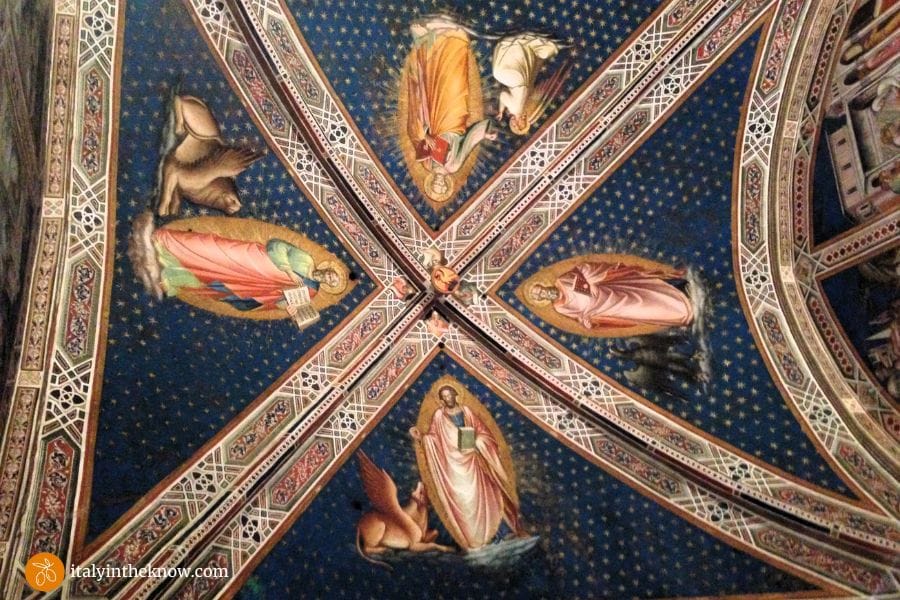
The sacristy contains beautiful frescos of scenes from the life of Saint Benedict. These were painted by Spinello Aretino in the 14th century. The work shows the influence of Giotto who taught Aretino’s teacher.
What Happened Here
250 – St. Minias becomes the first Christian martyr of Florence. The Roman Emperor Decius sentenced him to death for refusing to sacrifice to Roman gods. After several failed attempts, he was beheaded. The story goes that he picked up his head and carried it up the hill to the site which became the church.
1529 – 1530 – Michelangelo directed construction of walls around the church. This was to defend the city against the Medici who were trying to reestablish their rule of the city.
1553 – Cosimo I de’Medici expands the walls of the church into a true fortress.
Unique Add-Ons
Giardino dell’Iris -Iris Garden
The Iris Garden is down the hill from the church on the east side of Piazzale Michelangelo. It is open briefly each spring and entry is free of charge. Since Florence’s banner is a red iris on a white background, the city is a fitting location for the garden. The Italian Iris Society maintains the garden. So, check their website for dates the garden is open in the current year.
Giardino delle Rose -Rose Garden
The rose garden borders the Piazzale Michelangelo to the west. This charming garden contains over 400 varieties of roses and is a welcome break from the bustle of Florence. Designed by Giuseppe Poggi, it has been in existence since 1865. There is no charge to stroll the paths and enjoy a panoramic view of Florence.
Cimitero delle Porte Sante -Holy Doors Cemetery

Next to the church is the Porte Sante (Holy Doors) Cemetery. It is filled with famous Florentines, including Carlo Lorenzini (pen name Collodi) the creator of Pinocchio. It is a place of peace and serenity with interesting monuments, chapels, and statues.
Click to explore italyintheknow on Pinterest. Discover more insights, exciting destinations, and tips for an unforgettable journey. Prepare for a fantastic trip with italyintheknow as your guide!
